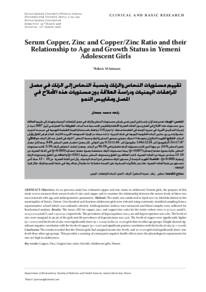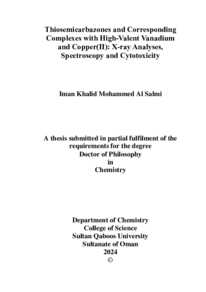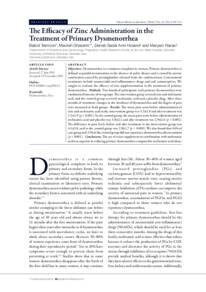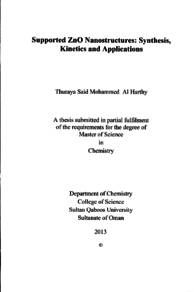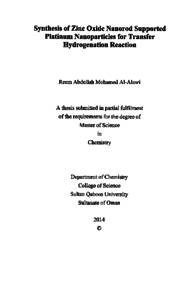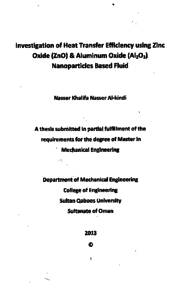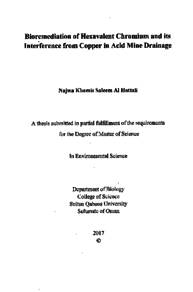Document
Serum Copper, Zinc and Copper/Zinc ratio and their relationship to age and growth status in Yemeni adolescent girls .
Other titles
تقييم مستويات النحاس والزنك ونسبة النحاس إلى الزنك في مصل المراهقات اليمنيات ودراسة العلاقة بين مستويات هذه الأملاح في المصل ومقاييس النمو
Publisher
College of Medicine, Sultan Qaboos University.
Gregorian
2008-11
Language
English
English abstract
As no previous study has evaluated copper and zinc status in adolescent Yemeni girls, the purpose of this study was to measure their serum levels of zinc and copper and to examine the relationship between the serum levels of these two trace minerals with age, and anthropometric parameters. Methods: The study was conducted in April 2007 in Alwehda district in the municipality of Sana'a, Yemen. One hundred and fourteen adolescent girls were selected using systematic stratified sampling from a representative school which was randomly selected. Anthropometric indices were measured and blood samples were collected for biochemical analysis. Results: The mean ±SD for copper, zinc, and copper/zinc ratio for the entire cohort were 17.47±3.31 µmol/L, 12.24±1.04 µmol/L, and 1.44±0.31, respectively. The prevalence of hypocuprimea was 4.4% and hypercuprimea was 2.6%. The levels of zinc were marginal in 96.5% of the girls and the prevalence of hypozincimea was 3.5%. The levels of copper were significantly higher (p = 0.007) and the levels of zinc were significantly lower (p = 0.003) in the 10-12 yrs girls than in other age groups. Height showed significant negative correlation with the levels of copper (p = 0.01) and significant positive correlation with the levels of zinc (p = 0.008). Conclusion: The results revealed that the Yemeni girls had marginal serum zinc levels, and 10-12 yrs girls had significantly lower zinc levels than other age groups. This provides a warning of consequent negative health effects since the physiological requirements for zinc are high in adolescence.
Member of
Resource URL
Arabic abstract
تعتبر هذه أول دراســة في اليمن تعني بقياس مســتويات النحاس والزنك في مصل المراهقات اليمنيات وتهدف إلى تقييم العلاقة بين مستويات هذه الأملاح في المصل وبين الفئات العمرية المختلفة والمقاييس الجسدية عند البنات. الطريقة: بدأ العمل في أبريل 2007 حيث تم إجراء التحاليل المخبرية في مديرية الوحدة في العاصمة صنعاء. تم اختيار 114 مراهقة باستخدام العينة الطبقية المنهجية في مدرسة اختيرت عشوائيا من بين مدارس البنات الحكومية الموجودة في تلك المديرية. تم أخذ عينات دم لإجراء الفحوصات المخبرية اللازمة. كما تم قياس أطوال وأوزان البنات. النتائج: أظهرت النتائج إن متوسط ± انحراف معياري مستوى النحاس والزنك ونسبة النحاس / الزنك في المصل عند كل البنات هو كالآتي: 17.47±3.31 مكرومول/لتر، 12.24±1.04 مكرومول/لتر، 1.44±0.31 على التوالي. كان معدل انتشار نقص النحاس 4.4% بينما كان معدل نقص النحاس 2.6%. من جهة أخرى كانت مستويات الزنك هامشية في 96.5% من البنات. ومعدل انتشار انخفاض الزنك 3.5%. كانت مستويات النحاس عالية بصورة معتدة إحصائيا (p=0.007) بينما مستويات الزنك منخفضة بصورة معتدة إحصائيا (p=0.003) في الفئة العمرية من 10-12 سنة من غيرها من الفئات العمرية. كانت العلاقة بين الطول ومستويات النحاس سلبية (p=0.01) والعلاقة بين الطول ومستويات الزنك إيجابية (p=0.008). الخلاصة: أظهرت الدراسة أن مستوى الزنك منخفض لدى البنات اليمنيات. وأن لدى الفئة العمرية من 10-12 سنة أدنى مستوى من بقية الفئات العمرية. هذا ينذر بالتأثيرات السلبية على الصحة خاصة إذا ما علمنا أن هناك زيادة في حاجة الجسم للزنك خلال فترة المراهقة.
Category
Journal articles

